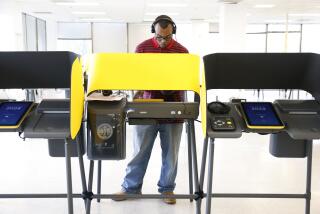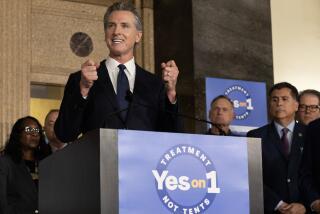Analysis: California officials ponder: Now that they’re registered, how do we keep new voters interested?
California’s elections officials are waiting for the answer to one question: Will the hundreds of thousands of Californians who recently signed up to vote actually show up for the June 7 primary?
And they are contemplating a second question: If they do, how do we keep them around?
Low voter turnout is a California tradition, born of socioeconomic factors and an overriding political reality. The state has a relatively young, diverse population and an exceedingly mobile one — all factors that correlate with unimpressive turnout. It’s also so lopsidedly Democratic in statewide races that people have less incentive to show up.
The problem is true in presidential contests, and even more true in other contests, like those for governor and statewide office. And turnout trails further in the primaries and in local races.
But this year, fate has stumbled onto a solution: In one race, feature a Manhattan real estate power-turned-reality television star who engenders both rapt support and widespread dislike. In another race, add a socialist running against the Democratic establishment while regularly starring, via his lookalike Larry David, on “Saturday Night Live.”
Add in a woman seeking to become the first of her gender to become president, and in California, you have the seeds of a more vigorous turnout than has been seen in recent years.
What happens after June 7 is a great question, and I wish we all knew the answer. Did that surge in registration translate to voting?
— Dean Logan, Los Angeles County registrar-recorder and county clerk
The recent record was the 2008 presidential election, which drew more than 79% of California’s voters to the polls for a landslide victory by Barack Obama.
The problem: It didn’t hold. A lesser 72% of registered voters cast ballots in the 2012 presidential race. In the 2010 governor’s race two years after Obama’s first win, 59.6% showed up, not all that much different from the 56% who had voted for governor in 2006.
Who registers, and who votes, matters.
A report by the Public Policy Institute of California before the recent registration surge found vast differences between voters who regularly take part in elections, those who are not registered at all and all Californians.
To take one measure, among Californians overall, 52% prefer the priority of paying down the state’s debt as it comes out of the recession, to 44% who wanted to restore money to social programs that were cut in leaner years. Likely voters sided more firmly with paying down debt — 59% to 38%. But nonvoters preferred funding social services, 50% to 44%.
Nonvoters were less prone than likely voters to think the state budget is a problem, and far more likely to support school construction bonds. Nonvoters also were more in favor of the government stepping in to “reduce the gap between rich and poor” and far more likely to support providing healthcare coverage to immigrants in the country illegally.
The differences occur because the two groups come from opposite spheres of the state’s residents, the PPIC survey found.
Among all California adults, 49% are 45 and older; almost half own homes, and 29% are college graduates. Likely voters are older and more apt to own a home — 68% in each category — and 43% have graduated college. But nonvoters are younger — 67% under 45 — predominantly renters, and only 17% have graduated college.
The influx of new voters this year dovetails with ongoing efforts by election officials to remake the voting experience so that those drawn in will stay in.
California officials already have simplified the registration system by sanctioning registration when residents either get or update a driver’s license or a state identity card. At a recent PPIC seminar on voting, Secretary of State Alex Padilla talked optimistically about an even bigger change in the way people vote.
Replacing the current system of either voting by mail or on election day at a precinct close to home would be voting that could be done either by mail, at centers anywhere in the county or via drive-by drop-offs of ballots. Many of those changes already are in place in Colorado.
“If you work for a living — and this is Los Angeles, folks, you know what, sometimes we actually have traffic — it can get tough getting to that one designated location,” Padilla said, speaking of the current system. “Imagine embracing technology that gives every vote center access to the entire voter list for the county so that voters have the option of going anywhere convenient for them in the county to be able to vote.”
Colorado now ranks third in the nation in terms of turnout, he said. California? Forty-third.
Los Angeles County registrar-recorder/county clerk Dean Logan concurs with what he calls “putting voting in front of people” so that voting comes to where they are, as opposed to voters having to contort themselves to cast ballots.
Campaigns have found that person-to-person contact results in a higher turnout. But that’s hard to pull off in a state this large. What can be approximated on a large scale, Logan said, is making registration easy and voting easier still.
A lot may ride, however, on how this year’s voters feel about their newly won franchise.
“What happens after June 7 is a great question, and I wish we all knew the answer,” Logan said in an interview. “Did that surge in registration translate to voting? Hopefully it does.
“From our perspective, where we can have some impact on that — if we have some impact — is do they leave with a sense of meaning in their votes? Were they able to cast a ballot and have it counted as they mean it to?”
Sen. Bernie Sanders has been trying to forge his voters into a lasting movement, but traditionally such efforts fail. Democrats already are worried about how many of his supporters will back Hillary Clinton, who is far more likely to be the nominee. If they feel their candidate was wrongfully denied, as many of Sanders’ supporters already do, the chances of them sticking around to vote in future elections would seem to be small.
Election officials have long held that likely voters are created out of habit; one election doesn’t guarantee a perpetual presence. But the more they vote, the more they vote.
The only other option for raising turnout seems highly unlikely: putting a reality star and a socialist with a “Saturday Night Live” doppelganger on every ballot.
Twitter: @cathleendecker. For more on politics, go to latimes.com/decker and subscribe to the free daily newsletter.
ALSO:
Why Bernie Sanders keeps popping up in out of the way places
Californians are registering to vote, but no one knows what it means for June 7
Sanders supporters sue to have voter registration deadline extended
California saw surge of new Democrats in first three months of 2016
California elections officials warn of ‘surge’ for June 7 primary
Registered to vote at the DMV? Check again.
Updates on California politics
Live coverage from the campaign trail
More to Read
Get the L.A. Times Politics newsletter
Deeply reported insights into legislation, politics and policy from Sacramento, Washington and beyond. In your inbox three times per week.
You may occasionally receive promotional content from the Los Angeles Times.







